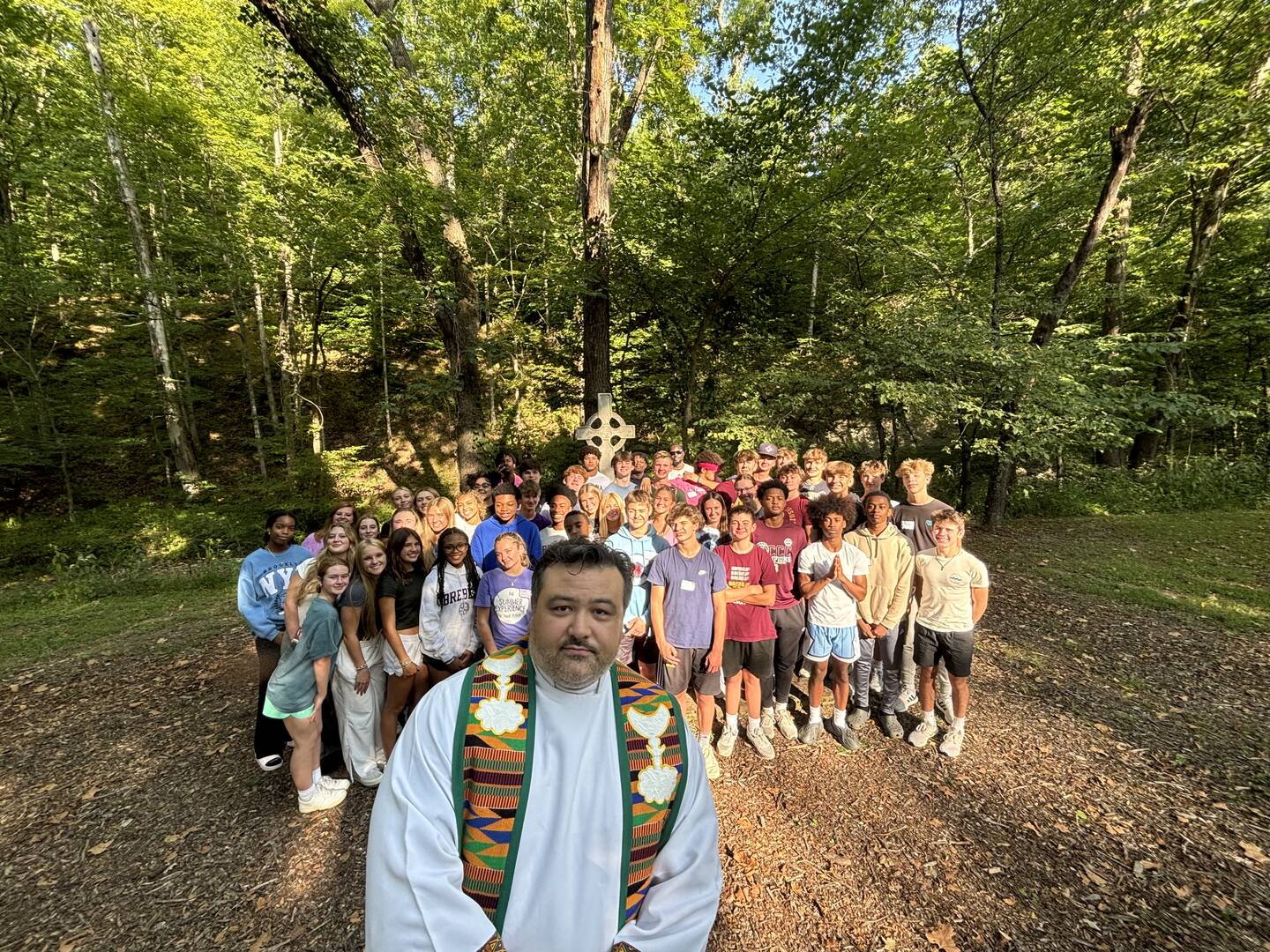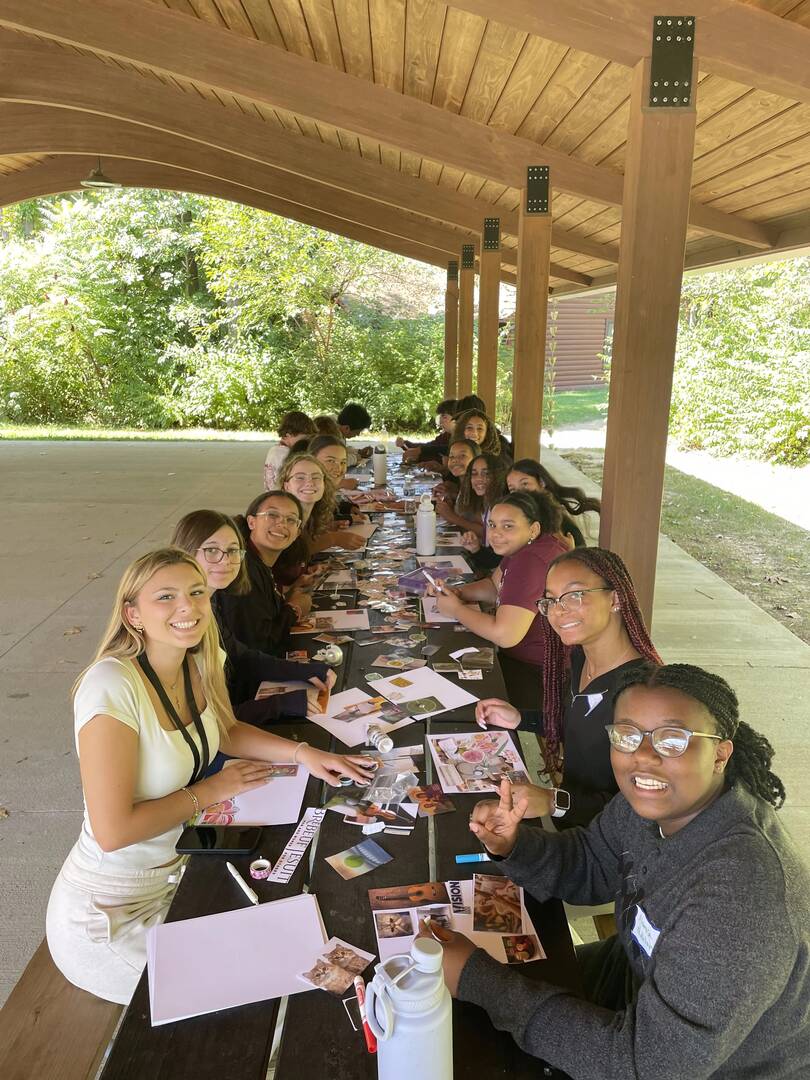Even though I interviewed high school student Samana Hassan for about 20 minutes, I never saw what she actually looked like, concealed as she was beneath a full-body Teenage Mutant Ninja Turtles outfit. It was Halloween at Brebeuf Jesuit Preparatory School, the Indianapolis high school where Samana, a junior, is known for going big with costumes on holidays and spirit days.
The culture of the school seems to invite such sartorial expression. Samana seems to be completely comfortable interacting with the faculty, staff and students at Brebeuf as a deformed, green-and-yellow martial reptile. “As a community,” she said in a 2024 interview at the school, “they’re open to anyone.”
The school’s acceptance of a free and creative spirit, a school that is “open to anyone,” relates in Samana’s case not only to her choice of costumes but also her identity as a Muslim. Among a school population that is only 40 percent Catholic, Samana is one of 11 Muslim students. She is vice president of the Muslim Student Union.
Brebeuf also has 28 Jewish students, and for years has sponsored a Jewish Student Union. The school’s heritage of educating a significant population of Jewish students led to it becoming known in Indianapolis as “the Jewish Catholic school.” Brebeuf also typically enrolls a handful of Hindu students along with adherents of other Christian denominations and a number of students who identify as agnostic or atheist.

The high school has always had a particular, niche identity among Midwestern Jesuit high schools for serving a multi-faith (or even “no faith”) population, of being “open.” In today’s religious culture, Brebeuf could also be seen as a model for other Catholic institutions for evangelization and interreligious dialogue.
For some non-Christian students at the school, learning about Christianity has helped them grow deeper in their own faith. Samana began to explore the tenets of Islam more thoroughly after engaging with the dynamics of Christian faith in class. “Brebeuf taught me to have pride in my religion,” she said. “I thought, ‘I’m learning about other people’s religion, and when they ask me about my religion I don’t want to not have an answer.’”
For senior Lexi Konev, a Jewish student, classes in Christianity helped her find similarities between Judaism and Christianity. “Even though I don’t believe in God in the same way as my peers,” she said, “we still believe in love and goodness and kindness in a way that fosters a positive community.”
Learning about the life of a first-century Jewish carpenter also provided a unique way into exploring her own religion. “During class when we learn about Jesus and what he lived through, I am able to reflect on the Jewish values that he lived out of,” Lexi said.
Shoring Up Catholic Identity
When it was built in 1962, Brebeuf High School was surrounded by farmland. Now the farmland is gone, and the renamed Brebeuf Jesuit Preparatory School resides on the northwest corner of the Indianapolis city limits, within walking distance of a Buffalo Wild Wings and a Walmart and close to a few affluent Indianapolis suburbs like Carmel and Zionsville. Brebeuf educates roughly 800 students, and its vast campus includes tennis courts, soccer, football and baseball fields and a cross-country course. A large statue of St. Jean de Brébeuf, the 17th-century Jesuit saint and martyr, greets the students and visitors as they drive onto campus.
Unlike other Midwestern cities with Jesuit schools, such as Milwaukee, Chicago, Detroit and Cincinnati, Indianapolis did not experience a significant influx of European Catholic immigrants in the 19th and early 20th centuries. Catholicism has never dominated the city’s culture as in those other industrial cities. Its principal, Greg VanSlambrook, said that from the get-go, Brebeuf always had to widen its net outside traditional churchgoing Catholics.
The net-widening has continued. “For a traditional Jesuit school,” he said, (namely, schools other than the Cristo Rey and Nativity model schools) “it has the smallest Catholic population of any school in the United States—or is on the edge of it.”
Over the years, Brebeuf’s understanding of its Catholic identity has evolved. In the 1980s, Mr. VanSlambrook said, Brebeuf “cultivated a hybrid—it identified itself as a Jesuit and interfaith school.” In fact, Brebeuf’s identity as “Jesuit, Catholic and Interfaith” was part of the school’s mission statement up until 2004, he said.
Over the past 20 years, Jesuit schools across the country have sponsored initiatives to shore up their Catholic and Jesuit identity. In that period, “the Jesuits felt Brebeuf had strayed too far from its core identification,” Mr. VanSlambrook said. “Brebeuf removed the identity of school as ‘interfaith’ because it couldn’t philosophically square that question about what is an interfaith school and Catholic school. You can’t be both.”
While Brebeuf no longer describes itself as an “interfaith” school, it still operates in an interreligious context. “Our approach is we are going to be a Jesuit, Catholic school that welcomes students of all faiths,” Mr. VanSlambrook said. “We would rather have that than for us to be a bland, watered-down [institution] that doesn’t identify with a specific faith tradition.”
In the early 2000s, Brebeuf brought back all-school Masses, which it had not held for decades. Megan Fridell, a Brebeuf junior, said that as a Jewish student, she feels comfortable at Catholic Masses. “I love listening to the sermons and students’ speeches,” she said. “The songs are really catchy. It’s a good learning experience, and they make you comfortable even if you’re not Catholic.”
Brebeuf still honors its informal reputation as a “Jewish Catholic school” by closing the school on Yom Kippur, the Day of Atonement—the holiest day of the Jewish calendar. “It really shows their effort to make us feel included in this community,” Megan said. “Brebeuf cares so much about their Jewish students; they treat us like the exact same.”
A Jewish parent, Todd Maurer, noted that the school taking Yom Kippur off was “unheard of in Indianapolis.” He said that “it means a tremendous amount” in the Indianapolis Jewish community and “speaks volumes about this Jesuit, Catholic school.”
Matt Couture, the former provincial assistant for secondary education in the USA Midwest Province of the Society of Jesus, said one of the most moving things he had witnessed at Brebeuf was when a Jewish parent said that Brebeuf is “our school.” This man had gone to Brebeuf, his children had gone there, and while they all identified as Jewish, he said this Catholic school was “ours.”
Muslim Student Union
The Muslim Student Union at Brebeuf was created a few years ago in the aftermath of inflammatory public comments made about the state of Israel by a Muslim student at Brebeuf. The following academic year, the school convened students and parents over several meetings on the issues of Muslim-Jewish relations. Out of this, both Muslim and Jewish students started the Muslim Student Union. At the end of the year, students organized and ran a panel discussion open to the entire community on the topic of Muslim-Jewish relations.
As Mr. Maurer put it: “That’s a special way of handling it—not ignoring it. It’s embracing the Jesuit way—let’s learn about each other. Let’s be men and women for each other and not against each other.”
In the years since the founding of the Muslim Student Union, Muslim and Jewish students have often gone to one another’s meetings, sharing food and learning about each other’s faith. During Jewish holidays, the Jewish Student Union holds a trivia game (they playfully call it “Jewpardy”) about Judaism for anyone to play and learn about the faith.
Brebeuf’s campus ministry makes an effort to reach out to non-Christian students in both small and large ways. Shaughn Phillips, the director of campus ministry, said that during a ceremony at a Kairos retreat, Christian students receive a cross, Jewish students a Star of David, Muslim students a crescent moon, Hindu students an aum or a lotus flower, and students who identify as agnostic can choose to receive a medal of a dove.

The campus ministry office also recently opened a “contemplation room.” It is a simply appointed space for students of all faiths or no identifiable faith to pray or take time apart from school for quiet and reflection. Mr. Phillips said that in his work with students of different faiths or those with non-identifiable faith, he is inspired by the words of the 13th-century Franciscan scholar, St. Bonaventure. “We love Muslims not because they’re Catholic but because we’re Catholic.”
Diversity can also benefit Christian students, Mr. Phillips said, “I have heard Christian students say that the openness of interreligious dialogue and religious diversity has helped reaffirm their own faith and articulate what they believe.”
Additionally, Mr. Phillips said that in his four years as campus minister, at least half a dozen students have joined the Catholic Church since going to Brebeuf.
Mr. Couture described how rare it is for any Catholic diocese in the country to have a school like Brebeuf that is “a portal for people of other faith traditions to enter into [a Catholic] school. In Indianapolis, there is this portal of entry into this school that Jewish and Muslim families want.”
Evangelizing at Brebeuf
The times have caught up with Brebeuf, Mr. Couture said, not only in terms of the school’s outreach to Muslim and Jewish students but to marginally Christian or even nonreligious families who may float in a sea of cultural indifference to religious practice. “By bringing Catholicism to a culture which is less and less Catholic,” he said, “Brebeuf is uniquely positioned to meet those families where they are and invite them to consider [the church] for themselves.”
As Mr. VanSlambrook put it, Brebeuf serves as a privileged place to share the good news of Jesus Christ. “Most of [these students] would not have an experience of Catholic or faith-based practice without being at Brebeuf. We are working with a population on the margins as regards how faith influences their life,” he said, “and we are bringing [faith] to them.”
Whether it has anything to do with its religious culture or not, one final takeaway seems to etch in stone something significant about life at this school. While the hallways at Brebeuf are lined with lockers that students secure their things in, there is one twist: No one uses a lock.








